![]()
![]()
![]()
Use LEFT and RIGHT arrow keys to navigate between flashcards;
Use UP and DOWN arrow keys to flip the card;
H to show hint;
A reads text to speech;
51 Cards in this Set
- Front
- Back
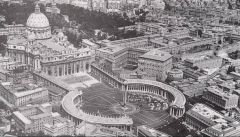
|
"St. Peters", 1600, Italian Baroque
Facade: Maderno, classical, but less like an ancient (pagan) temple, has dome, pillars, Courtyard: Bernini, meant to be either like a keyhole, or like the church's arms reaching out to you |
|
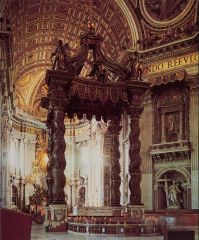
|
Bernini, "Baldacchino", 1650, Italian Baroque
for St. Peter's in the Vatican, marks his tomb made to celebrate popes at the time as well (bees) little papal babies counter reformation: shove extravagance in the protestants' face....drama pulls people in twisty=dionysian |
|

|
Bernini, "Blessed Ludovica Albertoni", 1650, Italian Baroque
|
|
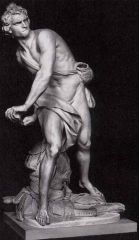
|
Bernini, "David", 1650, Italian Baroque
very dramatic, very in the moment, coextensive space, diagonals |
|
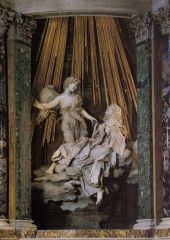
|
Bernini, "Ecstasy of St. Teresa", 1650, Italian Baroque
in Cornaro Chapel, shows that he is a sculptor/architect/set designer, he did whole area very dramatic: different colored marble, gentle hidden window glow, makes small space look really dramatic Very PERSONAL religious experience, meant to draw people back to the church through this guttural connection. moment of transverberation, angel comes down and pierced her heart with arrows. coronaro family is sculpted off to the side reading her biography and watching |
|

|
Bernini, "Scala Regia", 1650, Italian Baroque
|
|
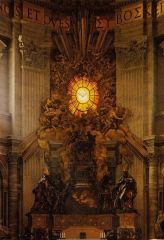
|
Bernini, "Cathedra Petri", 1650, Italian Baroque
giant reliquary of st. peter's throne, coextensive, looks like it's levitating 4 ppl, early theologians, support the throne physically below has dove above the head |
|
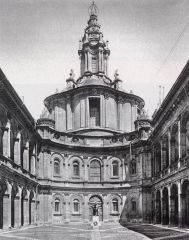
|
Borromini, "Chapel of St. Ivo", 1650, Italian Baroque
very complex, but very unified |
|
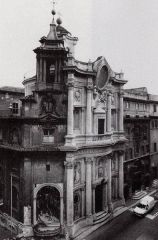
|
Borromini, "San Carlo alla Quatro Fontane", 1650, Italian Baroque
4 corners in an intersection, ornate undulating facade, curvature=instability pinched oval dome, corbelled with octagonals looks taller than it is inside way it is decorated inside is meant to move you, very unstable looking |
|
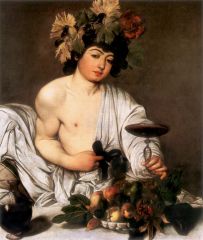
|
Carravaggio, "Bacchus", 1600, Italian Baroque
style coming out, intense lighting, slightly coextensive sleepy bedroom eyes=sexual/enticing god of wine and sensual things |
|
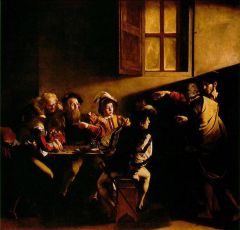
|
Carravaggio, "Calling of St. Matthew", 1600, Italian Baroque
Jesus calls on matthew, gesture shows who is who likely in a tavern, shows somewhat gritty details to make it more real, show it's jesus, but in our world |
|
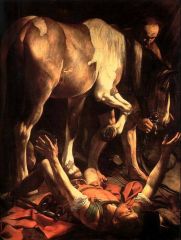
|
Carravaggio, "Conversion of St. Paul", 1600, Italian Baroque
forced chiaroscuro, cluttered composition, coextensive space, personal spiritual, in the moment very dark, REAL people |
|

|
Carravaggio, "Death of a Virgin", 1600, Italian Baroque
rejected by church, red=improper color, crass for virgin body is splayed, ankles swollen, like an actual dead person dark, dramatic, in the moment |
|
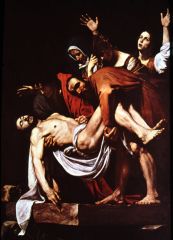
|
Carravaggio, "Entombment", 1600, Italian Baroque
forced chiaroscuro, cluttered composition, coextensive space, personal spiritual, in the moment |
|
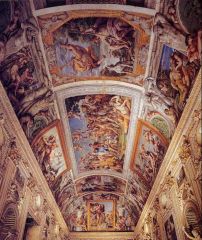
|
Carracci, "Farnese Gallery", 1600, Italian Baroque
ceiling, very much like sistine chapel, pieces with PAINTED frames, different sizes BAROQUE CLASSICISM |
|
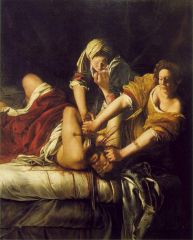
|
Gentilschi, "Judith of Holofernes" 1600, Italian Baroque
strong female heroines violent similar style to carravaggio dark dramatic, in the moment, coextensive like head will fall into our laps |
|
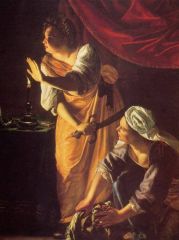
|
Gentilschi, "Judith of Holofernes" 1600, Italian Baroque
strong female heroines violent similar style to carravaggio dark dramatic, in the moment, coextensive |
|
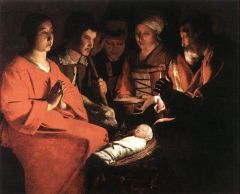
|
George de la Tour, "Adoration of the Shephards", 1650, French Baroque
carravaggio-esque, everyday sense of religious scene obscured light source |
|
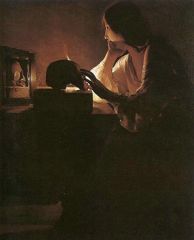
|
Georges de la Tour, "Repentant Magdalene", 1650, French Baroque
repenting, holds a skull momento mori, weird light source/candle, |
|

|
Hals, "Archers of St. Hadrian", 1630, Dutch Baroque
group portrait, protectors of the town, creators of dutch republic, diagonals lead the eye. busy composition |
|
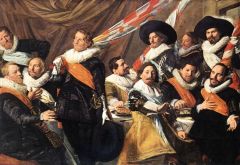
|
Hals, "Officer of St. George", 1630, Dutch Baroque
group portrait yada ya |
|
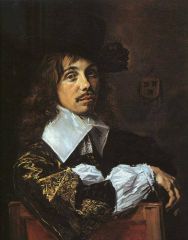
|
Hals, "Willem Coymens", 1650, Dutch Baroque
casual, nonchalant, haughty loose/sketchy brushstrokes |
|
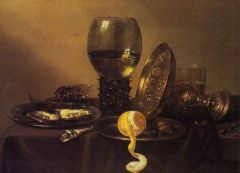
|
Heda, "Still Life", 1630, Dutch Baroque
decadent, rich foods, luxury every item has been touched by human hands, not perfect or glorified momento mori=watch, makes the beauty lesser |
|

|
Riguad, "Louis XIV", 1700, French Baroque Classicism
loved himself, his legs, his decadence very french baroque, but with classical roots (more stable, central etc) |
|
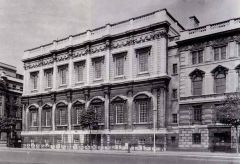
|
Inigo Jones, "Banquetting House at Whitehall", 1700, English baroque classicism
very much like the medici palace, super stable, sold, regularized, big |
|
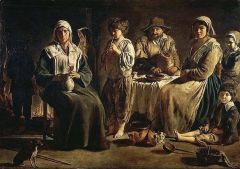
|
Le Nain, "Family of Country People", 1650, French Baroque
not poking fun at the peasants, just showing how different their life is bought by upper class as symbol of "other", world they don't belong to |
|
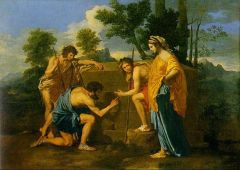
|
Poussin, "Arcadian Shephards", 1650, French Baroque Classicism
arcadia=mythical perfect land but here there is a TON of disguised momento mori, even in the idyllic world, figures/drapery=very classical also greek mythology stable forms refined brustrokes |
|
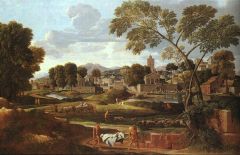
|
Poissin, "Burial of Phocion" 1650, French Baroque Classicism
draws eye from front back around greek=classical |
|

|
Poussin, "Rape of Sabin Woman", 1650, French Baroque Classicism
much less stable, repeated forms though help stabilize, figures/drapery=very classical refined brushtrokes make it more stable as well but very busy, complicated baroque composition |
|
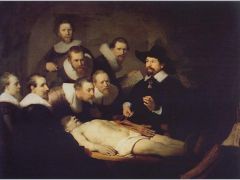
|
Rembrandt, "Anatomy Lesson of Dr. Tulp", 1630, Dutch Baroque
group portrait for a surgeon's guild, all equally displayed stacked, but equal |
|
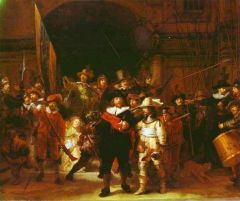
|
Rembrandt, "the Night Watch" 1630, Dutch baroque
Group portrait everyone is equal, individual, etc. dark |
|
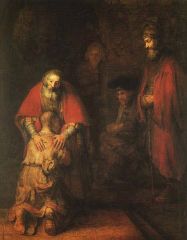
|
Rembrandt, "Return of the Prodigal Son", 1630, Dutch Baroque
somber/intimate moment |
|
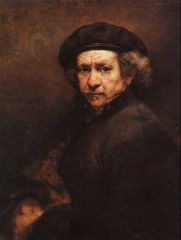
|
Rembrandt, "Self Portrait", 1660, Dutch Baroque
Realistic, looks tired |
|
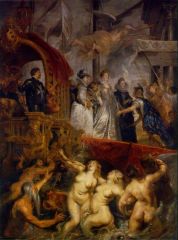
|
Reubens, "The Arrival of Marie de Medici", 1650, Flemish Baroque
influenced by Carravaggio, but more fleshy and loose brushstrokes allegorical/mythological, mix of fantasy, history and allegory |
|
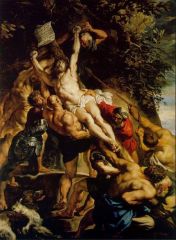
|
Reubens, "Elevation of the Cross", 1600, Flemish Baroque
influenced by Carravaggio, but more fleshy and loose brushstrokes shows defining moment, unstable influences of michelangelo- huge muscular forms looking up to heaven, extends canvas up to the heavens |
|

|
Reubens, "the Presentation of Marie de Medici", 1650, Flemish Baroque
influenced by Carravaggio, but more fleshy and loose brushstrokes allegorical/mythological: cupid presents it, Juno and Jupiter watch |
|
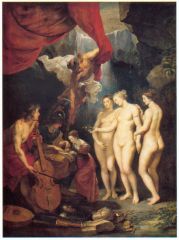
|
Reubens, "the Education of Marie de Medici", 1650, Flemish Baroque
influenced by Carravaggio, but more fleshy and loose brushstrokes allegorical/mythological taught by apollo and athena |
|

|
Van Ruisdael, "View of Haarlem", 1650, Dutch Baroque
very flat, focus on sky/horizon |
|
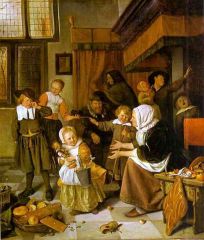
|
Steen, "Feast of St. Nicholas", 1650, Dutch Baroque
Shows traditional family scene, but also holds deeper allegorical meaning (pettiness, etc) |
|
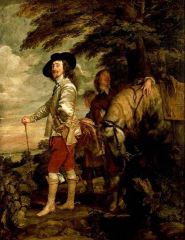
|
Van Dyck, "Charles I Dismounted", 1630, Flemish Baroque
more traditional than reubens, earthy tones/nature, emphasizes outdoorsy spirit still capable, still nice clothes doesn't feel like a king, more casual reubenesque brushstroke land shows his power, casual power, domain |
|
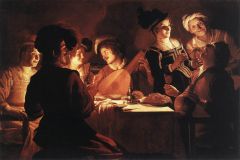
|
Van Honthorst, "Supper Party", 1630, Dutch Baroque
genre scene for middle class patrons, shows joy forced chiaroscuro but could also be a warning agains gluttony/lust |
|
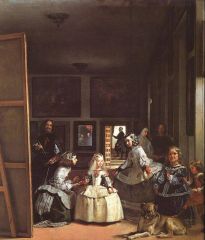
|
Velasquez, "Las Meninas", 1650, Spanish baroque
in the royal painting gallery, little princess mirror shows two figures, could be kind and queen (Velasquez could be painting them) interested in extending the space |
|
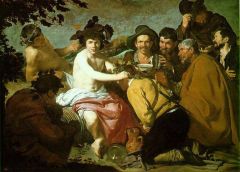
|
Velasquez, "Triumph of Bacchus", 1650, Spanish Baroque
moralistic painting, peasants are all drunk and goofy, drinking because their lives are so sad put in King Phillip IV's castle to make him feel good, MOCKERY of poor |
|
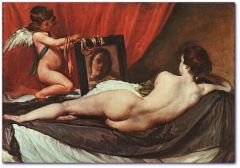
|
Velasquez, "Venus and Cupid", 1650, Spanish Baroque
curtain painting, mirror makes it an intimate space, she is unaware of viewer soft brushstrokes=sensual mirror also extends the space |
|
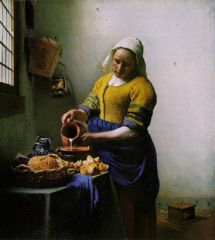
|
Vermeer, "Milk Maid", 1630, Dutch Baroque
Everyday woman, everyday tasks, master of light, smooth brushstrokes contrasting colors, idealizing the everyday |
|
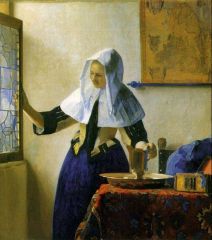
|
Vermeer, 1630, Dutch Baroque
Everyday woman, everyday tasks, master of light, smooth brushstrokes contrasting colors, idealizing the everyday |
|
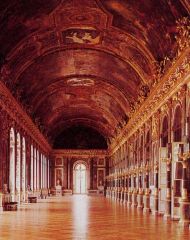
|
"Hall of Mirrors", Versailles, 1650, French Baroque
Overdone classical structure, incredibly decadent, bringing the outside in (sun reflecting mirrors= sun king) tons and tons of paintings, gold but very classical |
|
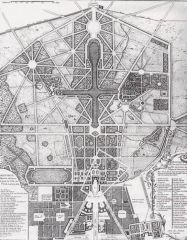
|
"Versailles", 1650, French Baroque
sprawling, fountains, classical architecture, very over done and ornate in the shape of a sun with rays coming out, like the sun king |
|

|
Zuberan, "St. Francis in Meditation", 1630, Spanish baroque
holds a skull, momento mori forced chiaroscuro, illuminates skull/prayer somber hole in the cloak shows humilty/lifestyle looking up, coextensive space with the heavens |
|

|
Wren, "New St. Paul's Cathedral", 1675, English Baroque
New st. peter's -esque |
|
|
Dutch Baroque
|
Genre Paintings
Group Portraits Landscapes Still Lifes paintings are secular, smaller patrons (homes) values: domesticity, equality, ideals of the republic |

